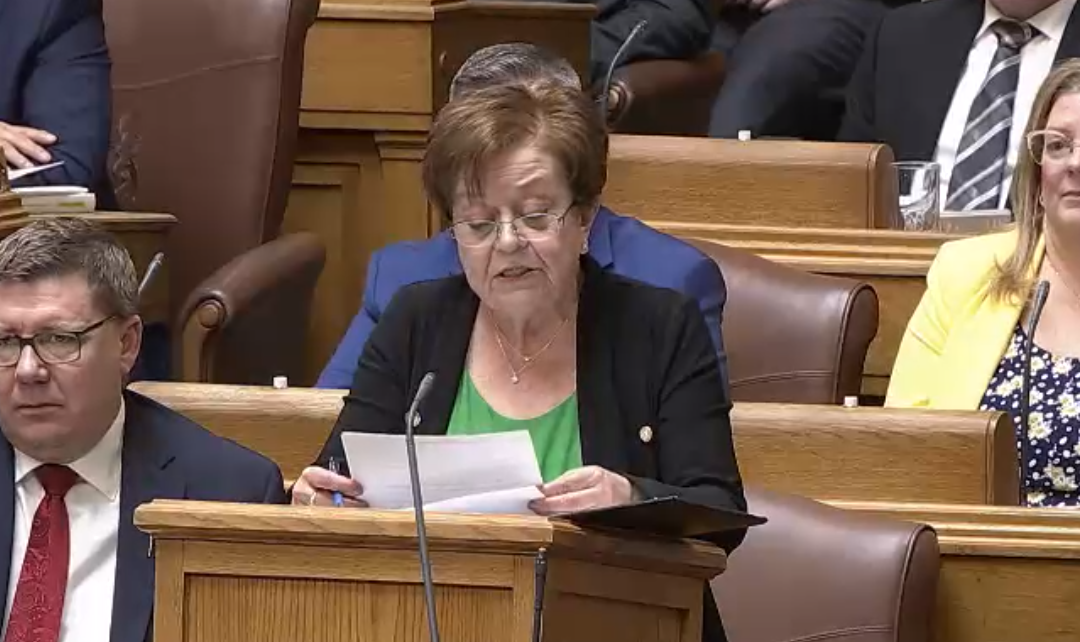The last provincial budget heading into the fall election is targeting two problem areas while shoring up SaskParty rural support. The 2024-25 budget tabled Wednesday by retiring Finance Minister Donna Harpauer focuses on health care and education, with record investments in both areas.
The Health Ministry will top nearly $7.6 billion dollars. The government has been criticized for not addressing medical imaging, with long wait-times for MRI, CT and breast cancer screening. Imaging and screening will see significant investment. Primary care, acute care and seniors care will see increases, expected to address pressures in not only the two major cities of Regina and Saskatoon, but elsewhere. A $3.5-million increase for breast cancer care and screening initiatives includes technology enhancements and new diagnostic imaging equipment, as well as the development of a Breast Health Centre of Excellence in Regina. A $1-million grant is designated for important ongoing ovarian cancer research.
In terms of northern investment, construction will continue on the Victoria hospital in Prince Albert at $180 million and the long-term care centre in La Ronge at $27 million.
With continued job action by teachers and a one-day strike today at the Legislature, the government is signaling it understands there are challenges in classrooms. $3.3 billion, an increase of nearly $250 million will be allocated to education. Premier Scott More has already announced that $356.6 million will go directly to addressing classroom size and complexity. Ongoing planning will continue for the replacement of the Minahik Waskahigan High School in Pinehouse; construction will continue on a new elementary school to replace Ducharme Elementary School in La Loche; and a new elementary school to replace St. Frances Cree Bilingual Elementary School in Saskatoon. The province is announcing a new project to provide a gym at the Moswakanisihk Community School in Jans Bay.
“More than $255 million in targeted funding will be provided towards First Nations Peoples and Metis organizations, which is an increase of $6.1 million over the previous year,” Harpauer explained.
In First Nations and Metis funding, casino and gaming revenues are anticipated to climb again, topping nearly $92.4 million. Earlier this week, provincial figures released for the previous year amounted to $91.2 million. The Missing and Murdered Indigenous Women and Girls+ Community Response Fund will invest $800,000 for grassroots organizations and communities developing and delivering projects that contribute to preventing violence, building safety and fostering the wellbeing of Indigenous women, girls and Two-Spirit people. An additional $2 million to $27.6 million will be directed to post-secondary institutions and career-training opportunities for Indigenous peoples.
On Northern roads, Thin Membrane Resurfacing will take place on Highway 155 south of La Loche. Gravel work will commence on Highway 924 north and south of Sled Lake. Culvert replacement will take place on Highways 106 and 135.
Finance officials said there is no contingency fund for wildfires this season, as it is anticipated there will be significant fires. While firefighters will have the resources needed to battle blazes, the province may issue special warrants to provide additional funds if needed. $95 million will directed to wildfire response activities.
$5.5 million will go toward the purchase of four re-purposed land-based airtanker aircraft, consisting of two Dash 8-Q400AT models and two Dash 8-Q400MRE models for an approximate cost of $187.0 million over the next three years. The planes will replace the current fleet of land-based airtanker aircraft, which consists of four Convair 580 airplanes. The current fleet has a life-span until 2027. The province said Ottawa is also helping with the purchase of the airtankers.
For municipalities, Premier Scott Moe last week announced an increase of $42.4 million to revenue sharing, a 14 percent increase from last year.
Harpauer said this budget is tight, as it forecasts a modest deficit of $273 million.
“It is the budget I am comfortable with. My colleagues and Premier decided to prioritize substantive increases was the right thing to do right now. I am really truly comfortable with those decisions,” Harpauer said.
Heading into a potential October election, the SaskParty said it is not introducing any new taxes or raising current taxes. Revenues will total $19.9 billion, yet expenses will be projected to be $20.1 billion, leaving a deficit of $273 million. The budget forecasts a return to balance next year. Provincial debt will climb $3 billion this year from $31.8 billion to $34.8 billion to help support capital projects.
The New Democrats continued to push for relief at the pumps with a temporary pause to the provincial gas tax, which was not included in the budget, with government stating that money was used to repair roads and highways.
“The Sask. Party had a real chance to show that they are listening and get the challenges folks are going through, and they blew it. Saskatchewan families are breaking the bank just to fill the tank and this government still didn’t suspend their 15-cent tax on gas and diesel,” said Leader Carla Beck. “We’ve been calling for some of these measures for months, like better breast cancer care and more training seats, but we have zero faith that the Sask. Party will be able to fix the crisis they created. The party that broke our hospitals can’t be trusted to fix them. This province used to be a nation-leader in healthcare. If there was ever a time to pop the hood on our health system and repair it from the ground up, this budget would have been it.”
